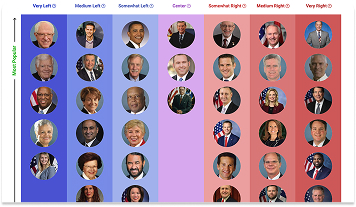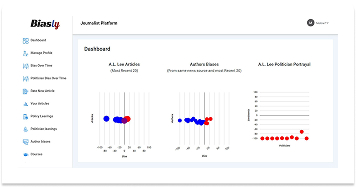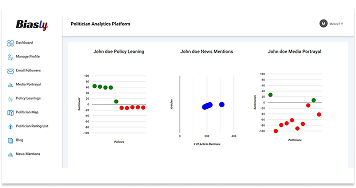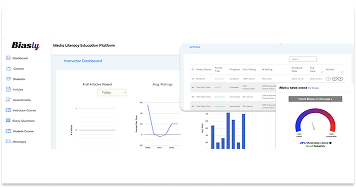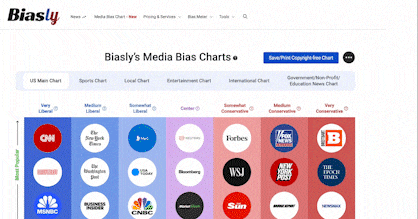Bias Meter
Extremely
Liberal
Very
Liberal
Somewhat Liberal
Center
Somewhat Conservative
Very
Conservative
Extremely
Conservative
-100%
Liberal
100%
Conservative

Biasly determines media bias ratings through a dual-layered approach combining artificial intelligence and analyst review. The platform’s proprietary bias detection engine, Bias Meter, evaluates sentiment, policy position alignment, and language framing across thousands of data points in news articles. Analysts then verify and interpret the AI’s findings, providing additional context where needed. Learn more
- Profile
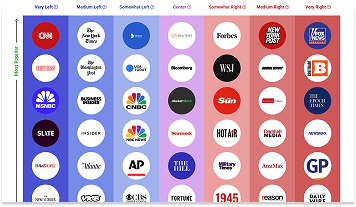
The Hill on the media bias chart
The Hill has a Bias Score of 2% Center which is based on a variety of factors including its policy and politician leanings, article ratings, and the use of biased language. Its Reliability is rated as Good, and additional analytical insights are available in the other tabs.
- Bias Rating
2% Center
- ReliabilityPolicy Leanings
20% Somewhat Right
Extremely
LiberalVery
LiberalModerately
LiberalSomewhat Liberal
Center
Somewhat Conservative
Moderately
ConservativeVery
ConservativeExtremely
Conservative-100%
Liberal100%
Conservative
Average Reliability
*Our bias meter rating uses data science including sentiment analysis, machine learning and our proprietary algorithm for determining biases in news articles. Bias scores are on a scale of -100% to 100% with higher negative scores being more liberal and higher positive scores being more conservative and 0% being neutral. The rating is an independent analysis and is not affiliated nor sponsored by the news source or any other organization.
Politician Portrayal22% negative
Continue For Free
Create your free account to see the in-depth bias analytics and more.
By creating an account, you agree to our Terms and Privacy Policy, and subscribe to email updates.
Policy Leanings Analysis
Policy | Bias score |
|---|
The Hill Editorial Patterns
The Hill’s coverage of political topics has a pattern of leaning Somewhat Right, with occasional Somewhat Left coverage, depending on the topic. For the most part, The Hill has consistent patterns in phrasing, source selection, and thematic focus that are politically moderate. The publication demonstrates journalistic standards in many of its reports, though the choice of issues, framing, and word usage can indicate a political slant from issue to issue. This content analysis examines how The Hill handles liberal and conservative issues and evaluates its language choices and editorial tendencies.
Coverage of Liberal vs. Conservative Topics
The Hill covers a wide range of political topics. This publication tends to value relevant and breaking news about policy matters from both sides of the aisle. This means that their coverage is fairly well-balanced. The Hill’s selection of topics that they regularly report on does not have a glaring political bias. More liberal or left-leaning topics seemed to be covered in an equal proportion to more conservative and right-leaning topics. Sometimes the framing of these policy stances has an ideological spin, though The Hill generally tries to minimize that problem.
This includes coverage on politicians as well. Like most of its topics, The Hill covers Democratic and Republican campaigns and politicians pretty evenly. Their emphasis on factual reporting on politicians will often provide a barrier to misinformation and overt bias. However, The Hill does appear to have a faint, but noticeable trend when it comes to this kind of coverage.
The Hill’s reporting on Democratic politicians is mostly balanced. But, every so often, there will be slightly conservative coverage. This aligns with their pattern of occasional right-leaning news. The Hill demonstrates this in their reporting on Vice President Kamala Harris. News on Harris focuses on her political plans and polling statistics. Harris is often quoted directly as well. However, some reports use cutting language to subtly cast a negative tone about Harris.
One article revolves around a prediction that Harris will criticize President Donald Trump in her post-White House address. Journalist Alex Gangitano writes:
“Former Vice President Kamala Harris will jab at President Trump in the keynote address at the Emerge gala on Wednesday.”
Already, this is a strange topic to highlight, since it is about a small aspect of speech that has not happened yet. Additionally, a politician criticizing another politician in and of itself is not particularly surprising or newsworthy. This selection of reporting and framing seems to paint Harris as a bit vindictive or overly critical.
The specific words Gangitano uses here also indicate a degree of bias. Writing about how Harris will take a “jab” at Trump, how she will give “pointed” criticism, and the “swirling speculation” about her next political moves. These words are not boldly charged, but they do create a picture of coldness, aggression, and secrecy.
This slight bias seems to carry over in reporting on conservative politicians. Like Harris, Vice President JD Vance is often the subject of fact-based reporting that makes frequent use of his direct quotes. News about Vance is policy-focused, more than sensationalist. However, unlike Harris, Vance periodically receives positive coverage. Words associated with Vance in relevant articles include “success,” “wins,” “praise,” and “important role.”
These biases do not dramatically shake the foundation of The Hill’s journalism. Considering all things, there are many more grievous examples of partisan framing and biased reporting out there. However, it is critical to notice that these biases are present anyway. Being aware of these trends can prevent biased news from influencing our political opinions without our knowledge.
Policy and Issue Framing
The political issues The Hill covers also give us insight into their reliability. When reporting on the economy, environmental regulations, and most foreign policy, The Hill keeps a straightforward tone. These topics in particular lack a significant amount of partisan coverage altogether. In these arenas, The Hill stays fact-focused and prioritizes neutral framings. Within these articles, The Hill sticks closely to statistics and concrete policy decisions without any editorial commentary. The Hill is an excellent example of an unbiased news source on these topics.
The Hill’s coverage of abortion is also relatively balanced, though there is an occasional article that takes a more liberal stance. However, recent reporting on immigration has a noticeable, though light, lean to the left. Immigration coverage on ICE in particular emphasizes the terror and uncertainty around raids. Words and phrases like “fears,” “without evidence,” “heated,” “ramped up,” and quotes about “terrorizing” communities are common in describing these raids. In an article about ICE detaining a man in a clinic, journalist Josh DuBose writes,
“It’s not the first time federal immigration agents have been seen refusing to identify themselves or using physically aggressive tactics.”
In this sentence, DuBose characterizes ICE agents as defiant (“refusing to identify themselves”) and dangerous or extreme (“physically aggressive”). He also emphasizes the claim that these are repeat offenses (“It’s not the first time”). While these all may be true, the tone towards the issue of immigration raids casts an unfavorable view of ICE agents. As a result, these articles have a more politically left-leaning bias.
Though The Hill is sometimes susceptible to a liberal bias, it skews conservative on other topics. In reporting on the politics of identity, The Hill has a more negative outlook on policies around DEI at times. Most of the reporting on this topic is about institutional and corporate compliance with Trump’s DEI cuts. We can see this in many articles from The Hill, including ones about PBS and T-Mobile. This kind of policy coverage ignores or minimizes the pushback against these federal policies. As a result, The Hill comes off more conservative in this area.
The Hill will also often take a more right-leaning position when it comes to counter-terrorism efforts and national security. In the article “Hegseth: ‘We are postured defensively … to be strong’ in Middle East,” author Tara Suter mainly relays the views of the Trump Administration. Suter quotes Defense Secretary Pete Hegseth multiple times:
“‘Our job is to be strong.’”
“‘We are postured defensively in the region to be strong.’”
“‘‘America First’ means we’re going to defend American personnel and American interests.’”
Suter platforms comments with traditional conservative rhetoric about having a strong military presence abroad. However, she does not provide any nuance or alternative understandings in this article. The ‘America First’ sentiment and endorsement of military involvement in the Middle East certainly is not politically universal. Some may even find those ideas at odds with each other, but Suter does not point this out. The article just regurgitates talking points from the current Administration. Intentionally or otherwise, Suter tinges the article with a conservative tone by neglecting to consider the diversity of political stances on this topic.
The Hill also seems to favor increasing the defense budget. Reporting on this topic frames these increases as a “boost,” “strengthening,” and an “investment.”
Despite these lapses in neutrality, The Hill does make a concerted effort to remain as unbiased as possible in its policy reporting. This does not always happen, but these blunders are more infrequent in The Hill than in other publications.
Coverage and Relevance
As a primarily (almost exclusively) political news outlet, The Hill constantly covers topics in ways that demonstrate larger conversations about bias in the news. This publication is also well-known for committing to balanced reporting. As a result, both The Hill’s continuity with and deviations from this commitment provide analysis about the inner workings of biased media. Through studying what and how The Hill covers news, we learn about what unbiased journalism looks like. We also learn that no outlet is bulletproof from bias, even when they generally abide by ethical standards.
If you want to dive deeper into how The Hill covers and frames its stories, take a look at Biasly’s Media Bias Chart to get a great sense of how it stacks up against other publications.
The Hill Bias Analysis
The Hill was established in 1994. Its mission is to:
“Connect the players, define the issues and engage Washington’s decision
makers in the debate.”
Its primary focuses are on politics and business. This outlet offers in-depth coverage on American politics, including congressional coverage, reporting on the Presidential Administration, business and lobbying, campaigning, and more. As of March 2025, The Hill has a print circulation of more than 24,000, and has more than 33 million unique monthly visitors.
In 2021, the Pew Research Center investigated which American news sources the public trusts and recognizes. The results indicate that The Hill is not widely recognized. Only 37% of Americans had heard of it. Outlets like CNN, The New York Times, and Fox News were well-known across all groups, and people had formed opinions about their credibility. Therefore, these outlets likely have a strong incentive to broadly cater to a certain audience. Since they have to please and appease their wide viewer base, biased reporting is all the more likely.
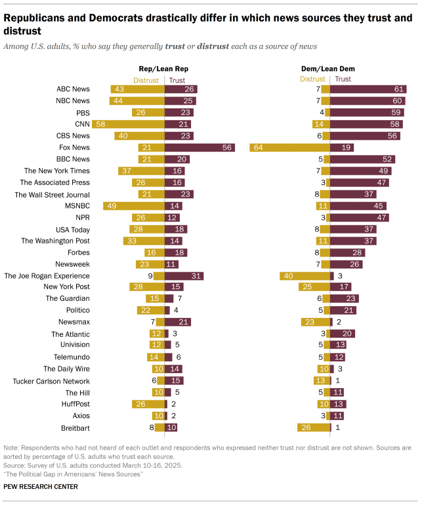
Source: Pew Research Center
The Hill, on the other hand, does not share this issue, at least not to the same extent. Since they don’t have quite the base that the mainstream outlets do, they have less of an incentive to produce politically biased content. Though not many Americans were familiar with The Hill, only 7% distrust it. This is wildly different from the 36% and 42% of Americans who distrust CNN and Fox News, respectively.
Here, we dive into The Hill’s editorial tendencies to explore if media bias is actually present.
Is The Hill Biased?
Based on Biasly’s evaluations, The Hill is rated as Center.
By examining content patterns and the broader context of media influence, we aim to offer a balanced perspective on The Hill’s political bias—and contribute to the ongoing discussion about media bias.
How Does Biasly Rate News Sources?
Biasly uses proprietary algorithms and a team of analysts to provide comprehensive bias evaluations across thousands of news outlets. Over 200,000 articles from more than 3,200 sources have been analyzed to identify the most accurate and unbiased stories.
Biasly assigns each outlet three key scores:
- Reliability Score – Reflects factual accuracy
- AI Bias Score – Generated via natural language processing
- Analyst Bias Score – Assessed by human political analysts
These scores are based on seven core metrics: Tone, Tendency, Diction, Author Check, Selection/Omission, Expediency Bias, and Accuracy. These elements help analysts and algorithms evaluate the political attitude conveyed by each article.
Biasly’s Bias Meter ranges from -100% (most left) to +100% (most right), with 0% indicating neutrality. The system evaluates individual articles based on political terms, policies, figures, and sentiment to calculate precise bias ratings.
Is The Hill Politically Biased?
The Hill earns a Center rating for its AI Bias Score and a Somewhat Left rating for its Analyst Bias Score. The Analyst Bias Score is generated by reviewers from liberal, moderate, and conservative backgrounds. Analysts reviewed 16 articles from The Hill and noted preferences in areas like positive coverage of initiatives from the GOP, but slightly more negative coverage of ones from the Democratic Party. However, the paper maintained objectivity on topics like the Black Lives Matter movement and the economy.
The subject of reporting aligning with conservative or liberal policy stances may influence the framing of the news. Overall, The Hill does its best to minimize this trend, though its slightly more right-leaning orientation on policy can peek through. Since The Hill is a national publication with a specialization in American politics, a certain level of bias in some topics is to be expected. Regardless, we need to be mindful of when it does occur, to make the most informed decisions for ourselves. We can do this both by knowing our own political biases and being aware of the political biases in the news we read.
This bias score is determined through natural language processing that evaluates the tone, word choice, and opinion embedded in the reporting. Recent AI evaluations highlight some conservative narratives regarding police reform and GOP initiatives around unemployment.
Analysis of Bias in The Hill Online Articles
The Hill professes to abide by several journalistic standards of integrity. The publication commits to editorial independence for all of its journalists. They aim to prioritize accuracy and truth, fairness and impartiality, independence, and transparency in all of their reporting.
But, the question remains: has The Hill’s approach to reporting still led them into the foray of media bias? Or have they remained true to their ethical standards of journalism? In a nutshell, is The Hill truly biased?
To evaluate this question, let’s walk through examples of articles from The Hill. To tackle this subject, we use 5 bias rating criteria at Biasly: Tone, Tendency, Author, Diction, and Expediency Bias. Here’s how we define each of these categories:
- Tone: The journalist’s approach to or attitude towards the topic
- Diction: The specific language that the journalists use
- Author: The journalist’s personal beliefs
- Tendency: The patterns within a journalist’s work history
- Expediency Bias: Visual and text features of the article that indicate unreliability or media bias.
A good place to start is Joseph Choi’s article, “Black Americans’ confidence in police recovers post-Floyd: Gallup.”
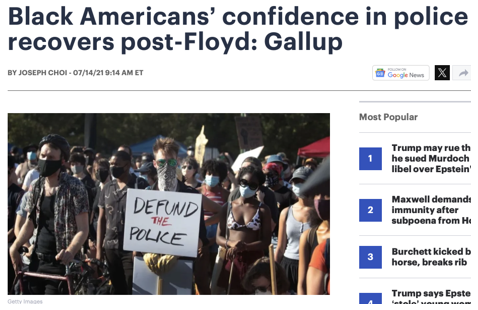
Source: The Hill
Right off the bat, there are two conflicting things happening. The headline itself is very neutral. There is no emotional language, the title is not clickbait-y, and it already attributes information to a reputable source (Gallup). The title is overall very neutral. However, the picture provided points to some bias. The image is of a masked protester holding a sign that says “DEFUND THE POLICE.” This picture captures only one side of the pro-police vs anti-police divide. Choi is either doing this to indicate a left-leaning sentiment or to utilize some moderately inflammatory imagery to encourage engagement with the article. The latter is likely the case, but the visual bias skew is evident regardless.
The rest of the article is much more measured than the image portrays. Choi writes very clearly and succinctly about the findings of the Gallup research. The article does not editorialize or frame the results. In the thesis statement of the topic, Choi writes,
“Overall, 51 percent of U.S. adult respondents said they have confidence in the police, which Gallup notes is an increase from last year, but is still below the reported confidence from before Floyd’s murder.”
This report does not provide any personal analysis or extrapolation of the concluding information. This article strictly pulls from the statistics and facts from Gallup to provide a comprehensive understanding of police sentiment. Choi does not just talk about Black Americans’ views of the police in a vacuum, either. He uses data from White and Hispanic Americans’ perspectives to provide context as well.
As a result, Choi constructed a very moderate and balanced summary of the Gallup results. Reporting on race and law enforcement can be highly polarizing, sensitive topics. By prioritizing factual reporting and a neutral framing, this article demonstrates The Hill’s capacity to provide unbiased news.
The Hill does occasionally fail to perfectly meet its standards of unbiased news. Even so, these articles generally don’t swing too partisan anyway. Take, for example, reporting on President Joe Biden’s post-COVID crisis proposals for government spending. In “Biden spending plans hit speed bumps,” Sylvan Lane, Amie Parnes, and Morgan Chalfant write about the many criticisms Biden’s plans received. Most of the article was pointing out the issues with the plans and used some subtly right-leaning language.
For example, the journalists characterized Biden’s economic situation at the time as “disappointing,” talked about liberals ‘ceding’ certain points, and centered a narrative where Biden did not listen to the “warning” an economist gave him.. Additionally, the journalists attribute many claims to vague groups of people like “the Democrats,” “Republicans,” and “economists.”
This adds to the feeling of general negativity and concern about Biden’s leadership, without ever having to name where exactly that is coming from. Most, if not all, of the information appears factually true. However, it is presented in an overwhelmingly apprehensive, maybe even concerned, way about Biden’s economic decisions. This makes the article seem ever-so-slightly right-leaning.
Why might this be? It could be the journalists’ political biases bleeding into their work. Sylvan Lane’s writing history potentially indicates a light left-leaning bias. Morgan Chalfant has a very moderate personal and professional presence. Amie Parnes, though, has a social media presence that is often very critical of the Democratic Party. Though she does not post her own thoughts very often, she has reposted statements on X like:
Democratic leaders who have hoarded power for decades should step aside. The Framers never intended for elected office to be a career or a way to get wealthy. Service should be finite and power should be shared. https://t.co/mDE92ZEGdl
— Shannon Watts (@shannonrwatts) July 11, 2025
And this statement (including a picture from a book she coauthored):
Wow the Kamala Harris team was secretly preparing to recreate the 1963 photo of LBJ being sworn in aboard Air Force One after the Kennedy assassination if Biden keeled over and died due to bad health and old age. Really insane and irresponsible Biden wanted to run again. pic.twitter.com/s0ANjpMHNI
— Rotimi Adeoye (@_rotimia) April 4, 2025
It is possible that Parnes’s voice came through stronger in this article. It’s also possible that the journalists did not realize that their article may appear slightly conservative. Nevertheless, this article still sticks pretty close to centrist reporting on Biden’s plans. It is a testament to The Hill’s efforts in neutral reporting that even their more biased news is still relatively factual and fair.
Analysis of The Hill’s Opinion Articles
To get a good grasp of political bias in the media, we have to keep in mind the differences between factual reporting and opinion pieces. Factual reporting presents facts and is supposed to let readers form their own conclusions. Opinion articles, on the other hand, express personal views on relevant topics. In the previous section, we took a look at factual reporting. In this section, we’re going to explore how bias manifests in The Hill’s coverage and tone of opinion pieces.
Harlan Ullman, a former US naval officer and business consultant, wrote an opinion piece for The Hill on the economy. His piece, “Pop goes the deficit: The warning signs are all there,” predicts the economic path the US is headed down as a result of government spending. He also offers potential solutions to our financial woes. Ullman makes heavy use of statistics, numbers, and very reputable sources to back his claim. Though Ullman expresses skepticism towards the Trump Administration’s proposed solution, he does so in a measured, neutral way. The language in this opinion piece is straightforward and factual. This report is a great example of an opinion piece that presents an argument, but does so in a measured and poised way. It’s also in alignment with Biasly’s journalist rating for Ullman.
Not all opinion pieces from The Hill are as balanced. Journalist and commentator Robby Soave puts out much more partisan opinion pieces. Soave published a commentary, headlined as “Jasmine Crockett has no idea how journalism works.” Already, this article makes use of inflammatory statements. Soave’s report does not hide its pessimism towards the Democratic Party and its negative view of Representative Crockett. This piece unabashedly calls Crockett “attention-seeking,” “offensive,” and “virtue-signaling,” and even compares her behavior to a reality show persona. Here, Soave shows his cards as a right-leaning commentator.
The Hill publishes a wide range of political views in its opinion section. Some align more strongly with its efforts to maintain neutrality, while some play to its more right-leaning issue portrayals. There are plenty of left-leaning opinion pieces in The Hill, too.
This framing tendency underscores the importance of recognizing when reporting is meant to be factual or an opinion piece. Like we’ve discussed, The Hill is a generally politically neutral publication. But if you only saw their opinion articles, you would not necessarily get that impression. This is a factor that we have to consider very carefully when we determine the political leanings of a news organization.
Who Owns The Hill?
The Hill was founded by Jerry Finkelstein, a businessman and power broker, and Martin Tolchin, a journalist. James Finkelstein took over the publication in 2012. In 2021, Finkelstein sold The Hill to Nexstar Media Group.

Source: Public Domain
Nexstar is a giant media conglomerate that owns a host of publications and TV stations. Nexstar is currently owned by Perry Sook. Finkelstein told The New York Times following the sale that he thought Nexstar was a good fit for The Hill, because the conglomerate is “very balanced.” Nexstar touts its belief in unbiased, fact-based journalism. Of course, this comes from a corporation whose job is to make money.
That being said, The Hill doesn’t rely on subscription revenue in the way many leading outlets do. In fact, subscriptions are not a big part of The Hill at all. All, if not most, of the coverage is available to anyone, with or without an account. The Hill is distributed in print for free around the Capitol and is sent to each and every congressional office. The Hill makes most of its money through advertisements.
An important point to note is that Nexstar has a history of donating vast amounts of money to GOP-affiliated PACs. They have recently begun giving to more Democrat-affiliated groups, though those are reportedly more moderate, centrist organizations.
How to Evaluate Bias
Although Biasly rates The Hill as Center, it’s important to remember that bias can vary from article to article. The Hill also covers a conservative-leaning slate with objectivity on many issues. This complexity underscores the importance of examining each article individually. So, let’s learn how to evaluate media bias.
Recognizing media bias requires awareness and critical thinking. Often, readers trust news sources that affirm their existing beliefs—a psychological tendency known as confirmation bias. This makes it harder to identify slanted narratives or one-sided reporting.
To combat this, it’s essential to challenge your assumptions by consulting multiple viewpoints and verifying news through third-party analysis. Tools like Biasly’s media bias ratings allow readers to compare the same news story across the political spectrum.
Ultimately, bias isn’t always a matter of what is said—it’s also about what is left out, how topics are framed, and which stories are chosen for coverage. Learning to recognize these patterns can help readers make more informed decisions and develop greater media literacy.
To start comparing news outlets and gain a better understanding of bias, sign up for Biasly’s Media Bias & News Analytics Platform to see how stories vary between sources.
The Hill Reliability Analysis
Is The Hill Reliable?
The Hill finds itself on the upper end of the spectrum, with a relatively high accuracy. Research from Gallup shows that 69% of Americans have little to no trust in mass media. A poll that measured public trust in institutions found that newspapers and television news were some of the least-trusted institutions. Only Congress garnered more distrust. Americans even trust the presidency and the criminal justice system more than news outlets!
As a national political news outlet, The Hill faces both high standards for reporting and more mistrust than ever before. This makes its reliability crucial to its reputation as an outlet. If an outlet is lacking in dedication to accuracy, political bias can run rampant. This is why media bias and reliability go hand-in-hand. As a result, we don’t just evaluate political bias at Biasly— we assess the reliability of media outlets, too. Let’s explore the accuracy and credibility of The Hill together.
How to Evaluate Reliability?
Reliability refers to how trustworthy or accurate a news source is. If we can’t trust what we read, then continuing to consume content from that outlet serves little purpose. So how do we evaluate a news outlet’s reliability?
There are several potential measures of reliability to look out for when trying to determine whether a media source is reliable or not. Red flags for an unreliable article can include the presence of wild, unsubstantiated claims, facts dependent on other unreliable sources, heavy use of opinionated language, and more. In contrast, hallmarks of a reliable source include:
- Absence of subjective language
- Citing credible sources (e.g., .gov, .edu, academic references)
- Verifiable facts and statistics from multiple outlets
- Use of primary sources, like interviews or transcripts
- Consistency with coverage across other platforms
Biasly’s reliability scores incorporate these elements in evaluating media outlets.
So How Does The Hill Fare in Its Reliability?
The political reliability index developed by Biasly assesses both accuracy and trustworthiness. The Hill currently holds a Good Reliability Score, which is calculated as a weighted average of:
- Fact Analysis Score – Evaluates the accuracy of claims, facts, and evidence.
- Source Analysis Score – Assesses the number, diversity, and credibility of sources and quotes used.
The Hill’s Source Analysis Score is rated Average. This suggests moderate trustworthiness in its sourcing practices. The score is AI-generated and considers quote length, frequency, diversity, and quality.
The Hill’s Fact Analysis Score is rated Good. This score reflects how well The Hill supports its claims, addresses selection and omission bias, and presents verifiable evidence. In addition to the Fact Analysis Score, readers are encouraged to perform their own evaluations using Biasly’s media bias tools.
While The Hill tends to provide very factual reporting, occasional instances of political bias or misrepresentation can affect its reliability rating. This affirms the importance of analyzing individual articles.
The Hill’s Accuracy and Reliability
According to Biasly’s analysis, The Hill maintains a Good Reliability Score, but individual articles may vary significantly. Let’s dive into the details.
The political orientation of reporting impacts the audience’s perception of the news in terms of its reliability. Though The Hill is known for its often neutral and unbiased reporting, there may be some claims otherwise. To validate such claims, it’s essential to analyze whether the publication backs its assertions with sufficient evidence and diverse viewpoints.
Two common types of bias that affect factuality include:
- Selection Bias – Highlighting or omitting stories to fit a particular narrative.
- Omission Bias – Leaving out differing perspectives or relevant details to skew perception.
Biasly’s accuracy ratings use a scale from 1% (least accurate) to 100% (most accurate). Factors include the presence of supporting evidence, internal and external reliable sources, and balanced viewpoints.
For instance, Biasly gave Palmer Report a bias score of Medium Left and a Limited reliability score. These two measurements are certainly correlated. Take, for example, this article from Palmer Report: “Donald Trump’s secret evil genius plan to turn the Jeffrey Epstein scandal in his favor.” This article uses a slew of highly inflammatory language to disparage the Trump Administration’s handling of the Epstein files. Journalist Bill Palmer writes about “every idiotic, incoherent, self-inflicting move that Trump and his regime have made.” Palmer also writes,
“Trump himself? He’s one of the most laughably ineffective political figures of all time. He’s the idiot who panders to his own base.”
This is by no means fact-based reporting. This article relies on heavily-biased personal political rhetoric to make strong, almost outlandish claims. Another article, “Idiot Donald Trump just screwed up a ceremony for a dog,” has similar issues. The headline alone is an indication enough. What’s more, author Ron Leshnower only includes one, singular source in this article. This seriously affects the credibility of the piece. The bias and reliability measures impact each other. The lack of appropriate sourcing and fact-focused journalism makes room for biased reporting, which decreases the reliability in turn.
Luckily, The Hill is better about keeping to its reporting standards. Let’s apply this kind of analysis to articles from The Hill to further investigate the reliability of the publication. Our breakdown will consider selection bias, omission bias, and the quality of the sources and facts The Hill uses.
Analysis of Reliability in The Hill’s Online News Articles
The Hill takes a lot of pride in its efforts to produce non-partisan reporting. Its staff includes writers from varying ideological backgrounds, which can help balance coverage. However, readers should distinguish between news reporting and opinion pieces to evaluate credibility most effectively.
One example that demonstrates The Hill’s factual reporting is Natalie Prieb’s article, “Ex-Cardinal McCarrick charged with sexual assault of teen.” Prieb carefully and accurately relays foundational information on a sensitive topic. This piece steers clear of any sensationalist or dramatized language and uses a handful of sources for such a short report. In keeping with The Hill’s Center rating, this piece illustrates factual neutrality.
Quality of Sources and Facts Used
The Hill often uses credible sources from across the political spectrum. The Hill has a reputation for producing work that is high in quality, with reliable facts. As a publication with a Good Reliability Rating, there is an abundance of examples to this point.
One of these examples is Sarah Polus’s article, “US women’s national soccer team players appeal equal pay decision.” The article provided updates and official statements on the women’s soccer team’s case status. This piece is well-documented and refrains from any editorializing commentary.
The article gains credibility through its 6 direct quotes from 4 sources—5 long and 1 medium-length. These full quotations provide sufficient context and minimize misrepresentation. Polus offers readers a very authentic and trustworthy account from primary sources. As a result, the reliability of this piece is high.
The article gathers information from 7 sources in total. 5 of these sources are from documents and people who are parties to, representatives of, or directly relevant to the case. This provides a huge boost of credibility to the report. Additionally, two other news outlets are referenced. The main documented sources are:
- CNN, a mainstream left-leaning outlet
- Judge Gary Klausner, the judge who dismissed the initial case
- The plaintiffs, made up of 28 current and former players on the team
- The Wall Street Journal, a slightly right-leaning outlet
- The appeal document
- Molly Levinson, a player spokesperson
- S. Soccer Federation, the defendant being sued
Polus’s article allows both the plaintiff and the defendant to be heard. Polus makes use of a few more quotes from the soccer team and their representatives than the USSF. However, the inclusion of Klausner’s rationale for dismissing the original filing helps balance the distribution pretty well. Not only does Polus balance the primary sources, but even the secondary media outlets each come from a different side of the political spectrum.
The article mostly relies on diverse primary sources, which enhance the credibility of the piece. This is ideal. Still, articles that take a different approach to sourcing are not necessarily less credible or factual. Rachel Scully wrote an article titled, “NAACP offers to pay bail for Texas Democrats who left state in effort to block election bill.” This report includes three internal links to other articles from The Hill, 2 direct quotes from the NAACP and its president, and 1 quote from Governor Greg Abbott through a Fox News interview.
The Hill, of course, is a moderate publication. The NAACP is a nonpartisan organization fighting for the rights of Black Americans. However, their values tend to align more closely with left-leaning ideas of social justice. Both Abbott and Fox News are right-leaning. The ideological diversity of the sources in this article is fairly well-rounded; there just are not many unique sources in total.
The sourcing of this article is less reliant on primary sources and more dependent on reporting that The Hill previously did. While not bad, this is not a perfect setup for high-quality, factual reporting. However, Scully still prioritizes the facts of the story, rather than the rhetoric. She stands on the shoulders of other reliable reporting done before this piece, and all of the information included appears to be true. The comparison between these two reliable and well-sourced articles demonstrates the variety in approaches to credible reporting.
Selection and Omission Bias
As we discussed, The Hill provides extensive, often well-balanced and neutral coverage of important stories in American politics. However, bias may still emerge through the stories they choose to select and how they frame them.
Another one of Polus’s articles, “GOP women’s group dismisses Greene and Boebert as ‘carnival barkers,’” is less well-rounded. This article provides information about a Republican fundraising group’s decision not to endorse Marjorie Taylor Greene and Lauren Boebert. The report relays quotes criticizing the two women’s personalities and political behavior.
There are two connected issues with this piece. First, the article only includes information from the PAC that is condemning Greene and Boebert. The selection of the quotes about the two politicians is entirely negative. The only perspective being platformed here is one in opposition to Greene and Boebert. This leads us to the second issue: any statement or argument in defense of the two women is completely omitted. There was no quote from Greene, Boebert, or any of their supporters to provide an alternative perspective. So, while Polus’s article is factually true, it does not give a comprehensive overview of the situation.
There was a similar problem in “Rand Paul vows to introduce public transportation mask mandate repeal.” The only quoted source in this article is Rand Paul himself. So, while he is a very credible source on his own opinions, there is no diversity of thought represented here. There is no ongoing, two-sided conversation occurring in the article. However, the information is still considered factual.
These two articles are very different from the pieces on the soccer team and the NAACP. Those reports made a concerted effort to represent the stances on both sides of an issue. There were direct quotes from those with a stake in the issue and several different sources from at least a few unique locations. The journalists did this to give an all-encompassing overview of the topics at hand. With the articles on Greene and Boebert, and Rand Paul, selection and omission bias contributed to the one-dimensional framing of the issue.
Again, to be fair, these lapses did not result in misinformation. But The Hill, like all other outlets, is subject to oversights in reporting that can knock the credibility of the article, even if the outlet itself is reliable overall.
So, Is The Hill Reliable?
Overall, The Hill can be considered a very reliable news outlet. It demonstrates a consistent goal of journalistic integrity and typically supports claims with sources and quotes. Occasional omissions and framing bias do appear, but they are minimal and have a low impact on reliability.
As media literacy improves, readers can more easily detect issues with selection bias, omission bias, and factuality. To strengthen your ability to assess reliability across the political spectrum, use the News Bias Checker to compare how multiple outlets report the same story.
This empowers you to consume more accurate, balanced, and dependable news.
Additional Insights
News Source Comparison
When it comes to news source comparison, The Hill falls among regional and national outlets that are considered moderate publications and have balanced reporting. These outlets frequently try to avoid perpetuating the issue of political bias in the media. Sources like Reuters, The Economist, or Foreign Affairs often present similar tones, framing, and journalistic ethics. As a non-partisan, Center-inclined publication, The Hill drastically differs from partisan sources. Unlike these sources, which include Vox and The Daily Wire, The Hill often includes opposing viewpoints and strives for nationwide coverage balance.
This puts it in contrast with more biased media outlets that present sensationalized, unreliable, and one-sided reporting on issues. Readers seeking balanced political coverage may compare The Hill’s framing of topics to outlets rated as Somewhat Left or Somewhat Right on our Media Bias Chart, or explore other moderate papers on our Similar Sources page.
Notable Contributors and Authors
The Hill hosts a wide range of accomplished reporters and commentators. Some notable contributors are Sharon Udasin and Rachel Frazin, who won awards for their reporting on environmental issues. Another significant contributor is Bob Cusack, who was The Hill’s former editor-in-chief. Cusack wrote for the publication for years, up until early 2025. This outlet was also the place where young journalist Sandy Hume broke the story of the attempted coup against Newt Gingrich.
Related Tools and Resource Pages
To better understand how The Hill fits into the broader media landscape, we recommend exploring these helpful resources:
- Media Bias Chart: See where The Hill ranks among hundreds of media outlets across the political spectrum.
- Political Bias Chart: Visualize political slants of news sources across various policy areas.
- Journalist Bias Analytics Platform: Explore how individual journalists contribute to bias within their publications.
- Politician Bias Analytics Platform: Compare how politicians are framed differently by The Hill and other outlets.
- Media Literacy Education Platform: Learn how to critically assess media sources, bias techniques, and news reliability.
Frequently Asked Questions
The Hill is rated as Center based on Biasly’s media bias algorithm, which assesses sentiment, article framing, and policy favorability.
The Hill has not suffered severe or persistent accusations of fake news and misinformation. The Hill has, however, been accused of censorship. One of its former commentators, Katie Halper, was fired following a news segment where she backed the claim that Israel is an apartheid state. Halper and her supporters implied that her firing was the result of censorship. Otherwise, The Hill is considered to be highly reliable and often reports facts.
Biasly uses a combination of AI sentiment analysis and human analyst review to assess tone, fact accuracy, source quality, and media bias indicators. Learn more on our Bias Meter page.
Yes. While readers must always maintain caution, The Hill generally provides fact-based reporting. Occasional partisan framing and selective reporting may be published, but they tend to have minimal effects on the reliability of the paper.
Ratings are based on recent news using data science and A.I. technology.
Military Spending
| Date | Sentiment | Associated Article | Snippet |
|---|---|---|---|
| 08/25/2019 | 75% For | Trump Family Detentions Flores Agreement (link) | So, of course, the Trump administration is doing the opposite in a baldfaced |






















